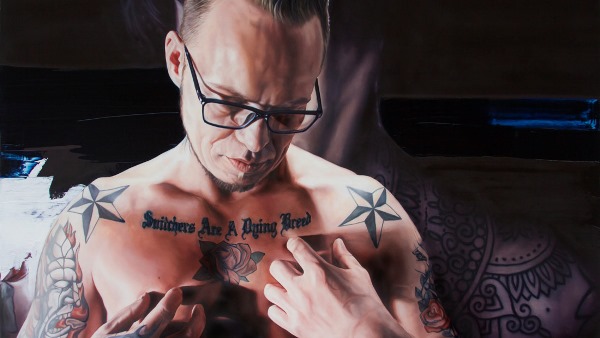
Filmed over years, focused on two attractively tormented personalities, and aglow with formal elegance, Benjamin Ree’s The Painter and the Thief boasts a full hand of cards that play both highbrow and sexy. The documentary is reaping critical praise and winning accolades, like the 2020 World Cinema Documentary Special Jury Award at Sundance. Tapping into the reservoirs of hope within all of us miserable sinners, Painter makes a mark with a semi-magical view of redemption, hyperrealistic yet juiced-up, like the artworks at the film’s center.
Ree follows a tangled artistic and personal odyssey between two unlikely counterparts by kicking off with a brazen theft. In 2015, promising young Czech artist Barbora Kysilkova is showing her work at Oslo’s Galleri Nobel—until a pair of her finest paintings are stolen off the wall. She reacts in disbelief watching security video of two men calmly strolling out with the pictures rolled up in rugs. The thieves are caught, but the paintings are still missing. Kysilkova confronts one of the robbers in the hope of tracking down the artwork.
Karl-Bertil Nordland, an addict and career criminal, baldly confesses to stealing the pictures because “they were beautiful.” Although he and his accomplice were sober enough to meticulously unpick 200 staples in order to pry the six-foot pictures out of their frames, the thief claims to have been too wasted to remember where he put the canvases, an assertion Kysilkova accepts without a challenge.
This very likely lie, swallowed and going down unquestioned, sets the tone for a long, deeply explored symbiosis tinged with manipulation. Nordland is talented and smart, but an abusive childhood has him trapped in a toxic cycle shuttling in and out of prison. His goblin-esque good looks catch Kysilkova’s artistic eye, his disarming sincerity wins her heart, and his many lurid tattoos take on symbolic significance. Soon that little matter of the theft is forgotten, and Kysilkova is painting Nordland’s portrait, alone or spread out in a Nan Goldin–esque sprawl with one of the many girlfriends who come and go in his life. Her pictures capture his more sensitive, vulnerable side and enshrine it in an almost religious light. Nordland’s seedier aspects are reserved for the screen, but rarely addressed. It’s one of the many silences that define the film as much as its declarations.
Nordland leads the classic addict one-man tango played out in films and, if we are unlucky, in the lives of those around us. Drugs relapses, a horrific car crash, and other setbacks pile up. Ree focuses on Nordland’s manly, violent struggles leaving Kysilkova less defined and less important in the story.
Apparently the painter escaped an abusive relationship, but this revealing detail comes from Nordland and not from her. She copes with artistic rejection and pushes back against an older husband who (sensibly) questions her attraction to a chronic recidivist while skirting the larger tensions in their relationship. But for much of the movie, we watch Nordland act out and Kysilkova react, part thug-life groupie, part radiant mommy figure. What’s in the relationship for her? Again, more intriguing silence, although we have our hunches.
Critics have rhapsodized about the sheer craft on display in The Painter and the Thief, and they are right to be wowed. Studio tableaux are bathed in transcendent light. The finding of a hidden object offers up a diverting plot twist. The director benefited from uncommon access to his subjects, capturing charged interactions that combine artistic heft with the voyeuristic thrills of reality TV, and a hard-won turnaround uplifts this moody, dark journey.
Yet qualms linger for those less moved by the transcendent powers of art and forgiveness. When Kysilkova first visits Nordland’s home, she is pleasantly surprised by the picture collection on his walls—who knew this bad boy could have such good taste? She examines a print by German Expressionist Käthe Kollwitz. “This could be an original,” she says approvingly. For a few of us, a cynical voice inside may pipe up: “Didja steal that too?”






Leave A Comment